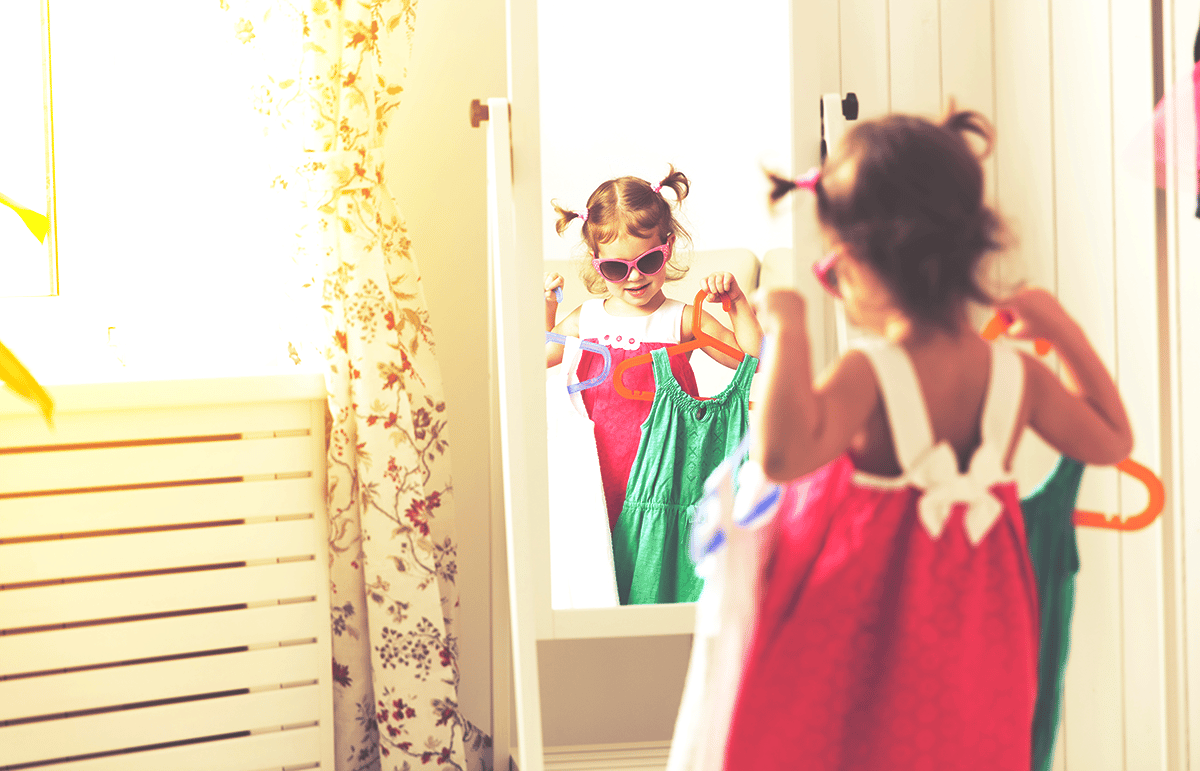Getting your child dressed and getting ready in the morning can be difficult, especially when you are also trying to make breakfast, load the car, pack the lunches, etc.
There isn’t always time to set up opportunities for your child to participate in dressing tasks, especially when it’s so much faster to just do it for them. Dressing skill development is one of the main activities of daily living addressed in occupational therapy! Dressing skills are so important to develop as they allow children the freedom to express themselves with their outfits. But when is the “right” age to expect your child to put on their shirt by themselves, or their socks, or shoes? Find your child’s age below for a summary of dressing milestones and tips for success. Keep in mind that these are estimates of typical development patterns. All children develop skills at different ages, and milestone averages are just that, averages.
Two Year Old Dressing Skills:
A two-year-old is typically expected to independently remove their socks and shoes as well as pants and underwear. If your child is constantly taking their shoes or socks off in the car, they are right on target with this developmental skill.
Tips for Skill Development: Taking off Socks, Shoes, and Pants
Try helping a little bit (i.e., pulling the sock over their heel and then leaving it for them to remove the rest, opening the Velcro on the shoe and having them take the rest off, etc.)
Increase participation in fun fine motor activities, such as squeezing squirt bottles to water plants, taking playdough out of containers, pulling Duplo blocks apart, or using tongs to “feed” different stuffed animals.
Three Year Old Dressing Skills:
A three-year-old is typically expected to put on and take off a pull-over t-shirt, put on socks and shoes (Velcro or slip-on), and puts on elastic-waist shorts/underwear. Three years is about when your child will start expressing their independence and will likely try to do everything themselves. Dressing is a great way to channel that independence!
Tips for Skill Development: Putting on T-Shirts and Pulling on Pants
Try helping a little bit and decreasing support over time. For example, help put the neckline over the child’s head and ask them to put arms through the sleeves. Or try putting the sock over your child’s toes and have them pull it over the heel.
Play games. Try hiding toys or puzzle pieces in socks during playtime and ask your child to practice opening the sock to find the treasure inside. This is a fun way of practicing stretching open the sock in preparation for putting it on. Or try arm or leg peek-a-boo with sleeves by holding them open and having your child “surprise” you with their arms or legs.
Four Year Old Dressing Skills:
Four-year-old’s are typically expected to get dressed by themselves independently, with the exception of fasteners (buttons, zippers, shoelaces, belts). They are also typically able to obtain the clothing from its location in their closet or dresser. This is the age where your child may pick out their outfit and opt to wear bright colors, mixed patterns, a tutu and Mickey-Mouse ears to school.
Tips for Skill Development: Obtaining Clothing and Dressing Independently
Play dress up! It is always more fun to practice putting on clothes when those clothes include a princess dress or a fire-fighter helmet! This is also a wonderful way to boost pretend play skills!
Have a tea party or picnic and encourage your child to get dressed for the occasion.
Your turn/My Turn: Take turns with putting on clothing during the morning routine. For example, help putting on their shirt, then encourage your child to take their turn by pulling pants on independently.
Hide and Seek or Scavenger Hunts. Ask your child to find different clothing items in their closet or drawer and bring them to you. Each time they find the right item, they get a point, sticker or happy face. Ask them to put them back away in their proper spots, for a bonus point! Have your child peel the sticker or draw the happy face for extra practice working on fine motor skills.
Five Years Old and Above:
At five, our children have reached the wonderful age of fasteners. This is when kids begin learning how to independently fasten buttons, latch zippers, close snaps, fasten buckles, etc. This can be frustrating at first for children to learn and succeed at, especially as their fine motor skills are continuing to develop and refine. I promise, though, it will get easier for them the more they practice.
Tips for Skill Development: Buttons, Zippers, and Snaps…Oh My!
Help at First. Start the button through the buttonhole and have your child push it through. Or latch the zipper and ask your child to pull it along its track.
Start with large buttons or snaps. Large buttons, zippers, and buckles will be easier for your child to practice with, before moving on to smaller sizes.
Hide and Seek. Put toys, stickers, or puzzle pieces inside clothing with the fastener you are working on and ask them to open the shirt to retrieve them. Try asking your kids to crab walk or bear walk to the hidden treasure to increase their gross motor coordination too!
Work on Foundational Fine Motor Skills: Fine motor strengthening, and coordination are important foundational skill areas to address in preparation for fasteners. Have your child to pull open and close packages or containers, water plants with spray bottles, string beads, or tear construction paper. Developing these fine motor skills will support independence with dressing tasks.
Overall…
All children develop and grow at their own pace. Be patient and encouraging during the process and try not to worry too much. When we are frustrated, our children get frustrated (better easier said than done, I know). Play activities incorporating dressing skills are a wonderful way to teach independence with putting on clothing, without the morning stress. Finally, praise and support all attempts your child makes at dressing, even if the shoes end up on the wrong feet or the shirt is backwards. This will boost your child’s confidence and willingness to try again.
As always, if you are worried about your child’s progress in self-care or dressing skills or are concerned about fine motor skills, gross motor coordination, or sensory processing, please contact Valued Voices for a complimentary occupational therapy consultation.

Kaelyn Green, MA OTR/L
Kaelyn is a licensed occupational therapist at Valued Voices. She received her master’s degree in Occupational Therapy from the University of Southern California and her bachelor’s degree in Child and Adolescent Development from California State University, Fullerton. She is certified by the University of Southern California in Sensory Integration and is an advocate for addressing underlying sensory processing to improve performance in our everyday roles and routines. She is passionate about meeting children and families where they are at and seeks to tailor interventions to the unique needs of her clients. When she is not working, you will find Kaelyn taking care of her two goldendoodles, working in her garden, or taking trips to the Central Coast.

